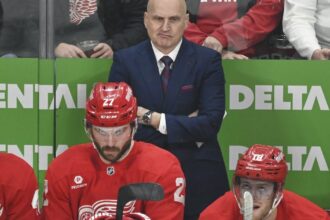The crisp autumn air at Yankee Stadium last night belied the absolute inferno that was ignited between the Toronto Blue Jays and New York Yankees in Game 2 of the American League Division Series. What began as a tightly contested playoff matchup quickly transformed into an offensive spectacle that had baseball purists clutching their scorecards in disbelief and casual fans transfixed by the scoreboard’s constant activity.
Toronto’s bats, seemingly dormant in Game 1, roared to life with a vengeance as they pummeled Yankees pitching to secure a crucial 13-7 victory, evening the series at one game apiece. This wasn’t merely a win—it was a statement delivered with the subtlety of a sledgehammer, reminding the baseball world that October narratives are written in unexpected ink.
The Blue Jays’ offensive explosion came primarily through the middle innings, turning what had been a close contest into something resembling batting practice. Vladimir Guerrero Jr., whose playoff pedigree seems to grow with each postseason appearance, delivered a performance that would have made his Hall of Fame father proud—driving in four runs and connecting for a home run that momentarily silenced the typically raucous Bronx crowd.
“We knew we had to respond after Game 1,” Guerrero told reporters through an interpreter. “This team has never lacked confidence, but tonight we needed to show it with our bats.”
The Yankees, despite the lopsided final score, demonstrated why they remain among the most feared lineups in baseball. Aaron Judge and Juan Soto each homered, continuing their postseason excellence, but their offensive contributions ultimately proved insufficient against Toronto’s relentless attack. The much-vaunted Yankee bullpen, a strength throughout the regular season, looked suddenly vulnerable as reliever after reliever failed to stem the Blue Jays’ momentum.
Yankees manager Aaron Boone, typically stoic regardless of circumstance, couldn’t hide his frustration during the post-game press conference. “We simply didn’t execute on the mound tonight,” Boone said, his voice betraying a mixture of disappointment and determination. “But this series is far from over. We’ll regroup and be ready when we head to Toronto.”
Indeed, the series now shifts to Rogers Centre for Game 3, where the decibel levels promise to reach new heights as Canadian fans welcome their team home with the series newly competitive. The Blue Jays’ coaching staff, led by manager John Schneider, faces the enviable yet challenging task of maintaining their offensive rhythm while managing a pitching staff that has shown signs of inconsistency.
What makes this particular Blue Jays-Yankees clash so compelling isn’t merely the geographic rivalry or the star power present in both dugouts—it’s the contrasting organizational philosophies at play. The Yankees, baseball’s perennial financial powerhouse, constructed their roster with a blend of homegrown talent and strategic free-agent acquisitions. The Blue Jays, meanwhile, have assembled a team largely through their player development system and trades, creating a core that has matured together through baseball’s competitive crucible.
As CO24 Culture has previously explored, these regional sports rivalries often transcend the playing field, becoming cultural touchpoints that reflect broader societal dynamics between cities and nations. The Toronto-New York baseball relationship carries particular significance as Canada’s team challenges the sport’s most storied franchise.
The statistics from last night’s offensive showcase will dominate headlines—20 combined runs, 24 hits, and 7 home runs speak to the entertainment value provided—but the strategic implications extend beyond the box score. Both managers now face critical decisions regarding pitching rotations, bullpen usage, and lineup configurations that could determine which team advances to the American League Championship Series.
For Toronto fans, who have experienced their share of postseason heartbreak in recent years, this victory represents more than just a series equalizer—it’s validation of their team’s resilience and potential. For Yankees supporters, accustomed to championship expectations, the loss serves as a humbling reminder that October baseball respects neither history nor reputation.
As the series continues, baseball analysts and casual observers alike will monitor how these evolving narratives shape the remaining games. Will Toronto’s offensive explosion prove to be an aberration or a awakening? Can New York’s pitching staff recalibrate after such a thorough dismantling? The beauty of playoff baseball lies in its unpredictability, in those moments where strategies collide with execution against the backdrop of immense pressure.
One thing remains certain: as the Blue Jays and Yankees continue their October dance, the drama that unfolded in Game 2 has ensured that baseball fans across North America will be watching with renewed interest. Sometimes, the most compelling sports stories aren’t found in dominance but in resilience—in the ability to respond when challenged. For one night at least, Toronto provided a masterclass in exactly that.
















